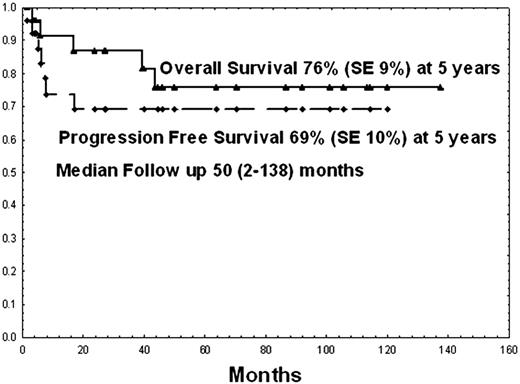Abstract
Abstract 2310
Poster Board II-287
NLPHL is an uncommon type of Hodgkin lymphoma characterized by nodules composed of large neoplastic B-cells (CD20+), lymphocyte predominant (LP) cells (previously known as L& H cells), associated with many small reactive B-cells. Patients with NLPHL typically have an indolent clinical course, but the disease can recur, often with histologic evidence of progression or transformation. Because of its rarity, limited information is available, mainly from retrospective studies. Very little information is available about salvage therapy particularly about the role of autologous transplantation in this disease. The purpose of this study was to evaluate outcomes of autologous transplantation in patients with relapsed or refractory NLPHL.
Patients and Methods: All patients with NLPHL who underwent autologous transplantation between January 1990 and December 2008 were included in this study. Pathology specimens were reviewed. The diagnosis of NLPHL was confirmed in all cases and, at time of transplant, many patients had histologic evidence of T-cell/histiocyte rich large B-cell lymphoma. During these 19 years, 26 patients (24 males) underwent autologous transplantation. Median age at transplantation was 35 years (range 13-51). At transplantation, 9 (35%) were in complete remission (CR); 13 (50%) were in partial remission (PR); and 4 (15%) had stable (SD) or progressive disease (PD). Median number of prior chemotherapy regimens was 3 (1-4). LDH was elevated in 10 (38%). Peripheral blood stem cells were used as stem cell source in 23 (86%) patients. Conditioning regimen were BEAM(10), BEAM-R(5), CBV(6), and other regimens in 5 patients. Peripheral blood stem cells were used as stem cell source in 23 (86%) patients.
Following transplant, 22 patients achieved complete remission. No treatment related mortality or treatment related MDS/AML occurred. Seven patients have relapsed. With a median follow up of 50 months (range, 2-138 months), the 5-year overall (OS) and event-free survival (EFS) were 76% (SE 9%) and 69%(SE 10%), respectively. For chemosensitive patients, The 5-year overall (OS) and event-free survival (EFS) were 82% (SE 10%) and 79% (SE 10%), respectively. Three out of 4 patients (75%) with chermoresistant disease relapsed compared to 4 out of 22 (18%) of patients with chemosensitive disease. Five patients died, all of recurrent disease.
High-dose chemotherapy and autologous transplantation is highly effective in patients with refractory NLPHL or relapsed NLPHL including patients with histologic evidence of transformation to T-cell/histiocyte rich large B-cell lymphoma, and results in long term remission in most of patients.
No relevant conflicts of interest to declare.
Author notes
Asterisk with author names denotes non-ASH members.


This feature is available to Subscribers Only
Sign In or Create an Account Close Modal